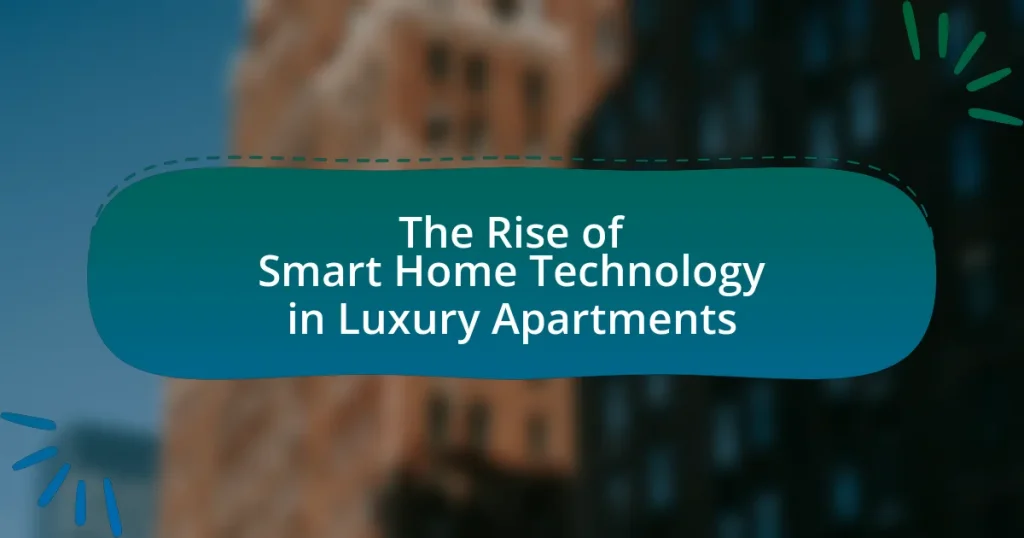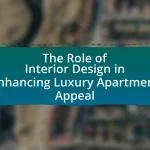Smart home technology in luxury apartments represents the integration of advanced automation systems that enhance convenience, security, and energy efficiency for residents. This article explores the evolution of smart home technology, highlighting key features such as automated lighting, climate control, and security systems, as well as the technological advancements driving this trend, including IoT and AI. It also examines the benefits for residents, the impact on property value, and the challenges associated with implementation, such as privacy concerns and technical issues. Additionally, the article discusses future developments and best practices for maximizing the smart home experience in upscale living environments.
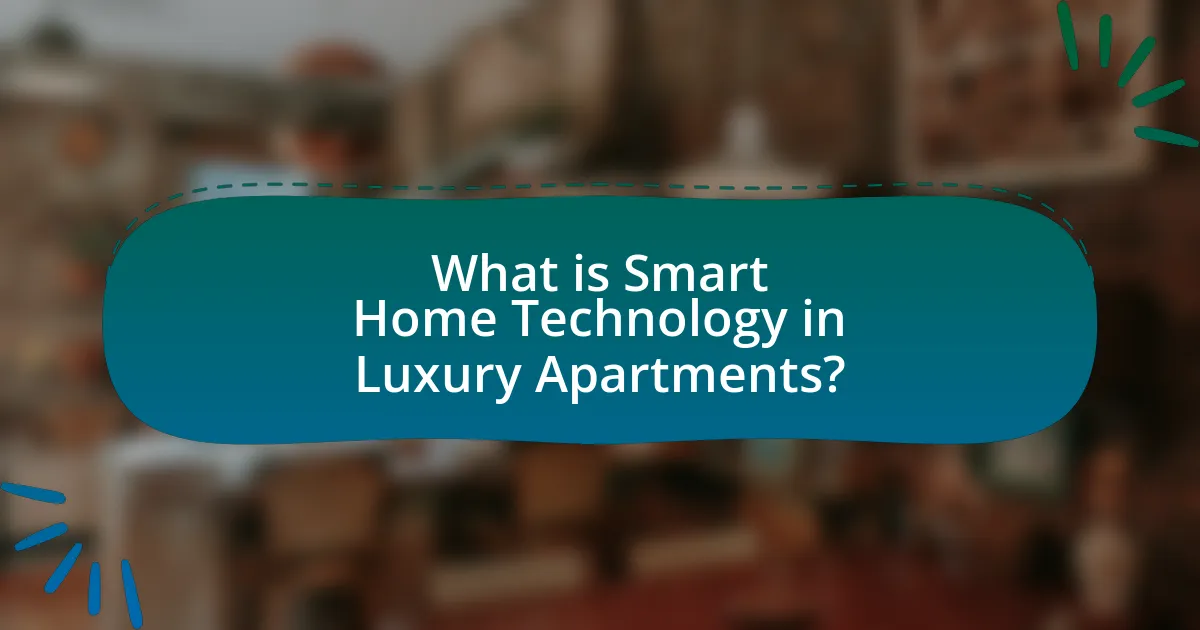
What is Smart Home Technology in Luxury Apartments?
Smart home technology in luxury apartments refers to the integration of advanced automation systems that enhance convenience, security, and energy efficiency for residents. This technology typically includes smart lighting, climate control, security systems, and home entertainment systems, all of which can be controlled remotely via smartphones or voice-activated devices. According to a report by MarketsandMarkets, the global smart home market is projected to reach $174 billion by 2025, indicating a significant trend towards the adoption of such technologies in high-end living spaces.
How has Smart Home Technology evolved in luxury living spaces?
Smart home technology has evolved significantly in luxury living spaces by integrating advanced automation, enhanced security, and energy efficiency features. Initially, luxury homes incorporated basic automation systems for lighting and climate control; however, the evolution has led to comprehensive ecosystems that allow seamless control of various devices through smartphones and voice-activated assistants. For instance, high-end residences now often feature smart thermostats, automated window treatments, and sophisticated security systems with real-time monitoring capabilities. According to a report by Statista, the global smart home market is projected to reach $174 billion by 2025, indicating a growing demand for these technologies in upscale properties. This evolution reflects a shift towards personalized living experiences, where technology not only enhances convenience but also contributes to sustainability and security in luxury environments.
What technological advancements have driven this evolution?
The technological advancements that have driven the evolution of smart home technology in luxury apartments include the development of Internet of Things (IoT) devices, advancements in artificial intelligence (AI), and improvements in wireless communication technologies. IoT devices enable seamless connectivity between various home appliances, allowing for remote control and automation. AI enhances user experience by learning preferences and optimizing energy usage, while wireless communication technologies, such as 5G, provide the necessary bandwidth for real-time data transmission and device interconnectivity. These advancements collectively contribute to the convenience, efficiency, and enhanced living experience that characterize modern luxury apartments.
How do luxury apartments integrate smart home technology?
Luxury apartments integrate smart home technology through the installation of interconnected devices that enhance convenience, security, and energy efficiency. These technologies often include smart thermostats, lighting systems, security cameras, and home automation hubs that allow residents to control various aspects of their living environment remotely via smartphones or voice commands. For instance, a study by the National Association of Home Builders indicates that 70% of luxury apartment developers are incorporating smart home features to meet the growing demand for modern living solutions. This integration not only elevates the living experience but also increases property value, making luxury apartments more appealing to potential buyers and renters.
What are the key features of Smart Home Technology in luxury apartments?
The key features of Smart Home Technology in luxury apartments include advanced automation systems, integrated security solutions, energy management, and seamless connectivity. Advanced automation systems allow residents to control lighting, climate, and appliances remotely, enhancing convenience and comfort. Integrated security solutions, such as smart locks and surveillance cameras, provide enhanced safety and peace of mind. Energy management features optimize energy consumption, often resulting in cost savings and environmental benefits. Seamless connectivity through high-speed internet and smart devices enables residents to manage their home environment efficiently. These features collectively elevate the living experience in luxury apartments, aligning with the growing demand for modern, tech-savvy living spaces.
Which devices are commonly used in luxury smart homes?
Luxury smart homes commonly utilize devices such as smart thermostats, automated lighting systems, advanced security cameras, smart locks, and integrated home entertainment systems. These devices enhance convenience, security, and energy efficiency, which are essential features in high-end residences. For instance, smart thermostats like the Nest Learning Thermostat can optimize energy usage by learning the homeowner’s schedule, leading to significant energy savings. Automated lighting systems, such as Philips Hue, allow for customizable ambiance and energy management. Advanced security cameras, like those from Ring, provide real-time monitoring and alerts, ensuring safety. Smart locks, such as August Smart Lock, offer keyless entry and remote access, while integrated home entertainment systems, like Sonos, deliver high-quality audio throughout the home.
How do these features enhance the living experience?
Smart home technology features enhance the living experience in luxury apartments by providing increased convenience, security, and energy efficiency. For instance, automated lighting and climate control systems allow residents to customize their environment effortlessly, improving comfort and reducing energy costs. According to a study by the National Association of Home Builders, 70% of homebuyers prioritize smart home features for their ability to enhance daily living. Additionally, advanced security systems, including smart locks and surveillance cameras, offer peace of mind by enabling remote monitoring and control. This integration of technology not only elevates the quality of life but also aligns with modern lifestyle demands for efficiency and safety.
Why is Smart Home Technology becoming essential in luxury apartments?
Smart Home Technology is becoming essential in luxury apartments due to its ability to enhance convenience, security, and energy efficiency. Luxury apartment residents increasingly demand seamless integration of technology into their living spaces, allowing for remote control of lighting, climate, and security systems through smartphones or voice commands. According to a report by Statista, the global smart home market is projected to reach $174 billion by 2025, indicating a growing trend in consumer preference for smart features. Additionally, luxury apartments equipped with smart technology can offer higher resale values and attract tech-savvy buyers, further solidifying the necessity of these innovations in upscale living environments.
What are the benefits for residents of luxury apartments?
Residents of luxury apartments benefit from enhanced living experiences characterized by superior amenities, advanced technology, and increased security. These apartments often feature smart home technology, which allows for automated control of lighting, heating, and security systems, providing convenience and energy efficiency. Additionally, luxury apartments typically offer high-quality finishes, spacious layouts, and access to exclusive facilities such as fitness centers, pools, and concierge services, which contribute to a higher standard of living. Research indicates that properties with smart technology can increase property value by up to 20%, demonstrating the financial advantages of residing in such environments.
How does smart technology impact property value?
Smart technology positively impacts property value by enhancing energy efficiency, security, and convenience. Properties equipped with smart home features, such as automated lighting, smart thermostats, and advanced security systems, often command higher prices in the real estate market. According to a study by the National Association of Realtors, 70% of homebuyers are willing to pay more for a home with smart technology, indicating a clear preference that translates into increased property values. Additionally, homes with smart technology can reduce utility costs, making them more attractive to potential buyers, further driving up their market value.
How does Smart Home Technology improve energy efficiency?
Smart Home Technology improves energy efficiency by enabling automated control of energy-consuming devices. This technology allows homeowners to optimize heating, cooling, and lighting based on occupancy and usage patterns, significantly reducing energy waste. For instance, smart thermostats can learn user preferences and adjust temperatures accordingly, leading to energy savings of up to 10-15% annually, as reported by the U.S. Department of Energy. Additionally, smart lighting systems can automatically turn off when rooms are unoccupied, further contributing to reduced energy consumption.
What role does security play in Smart Home Technology for luxury apartments?
Security is a fundamental aspect of Smart Home Technology in luxury apartments, as it enhances the safety and privacy of residents. Smart home systems integrate advanced security features such as surveillance cameras, smart locks, and alarm systems, which can be monitored and controlled remotely via smartphones or tablets. According to a report by MarketsandMarkets, the global smart home security market is projected to grow from $47.6 billion in 2020 to $82.3 billion by 2025, indicating a significant demand for enhanced security solutions in residential settings. This growth reflects the increasing importance of security in luxury living environments, where residents expect comprehensive protection against potential threats.
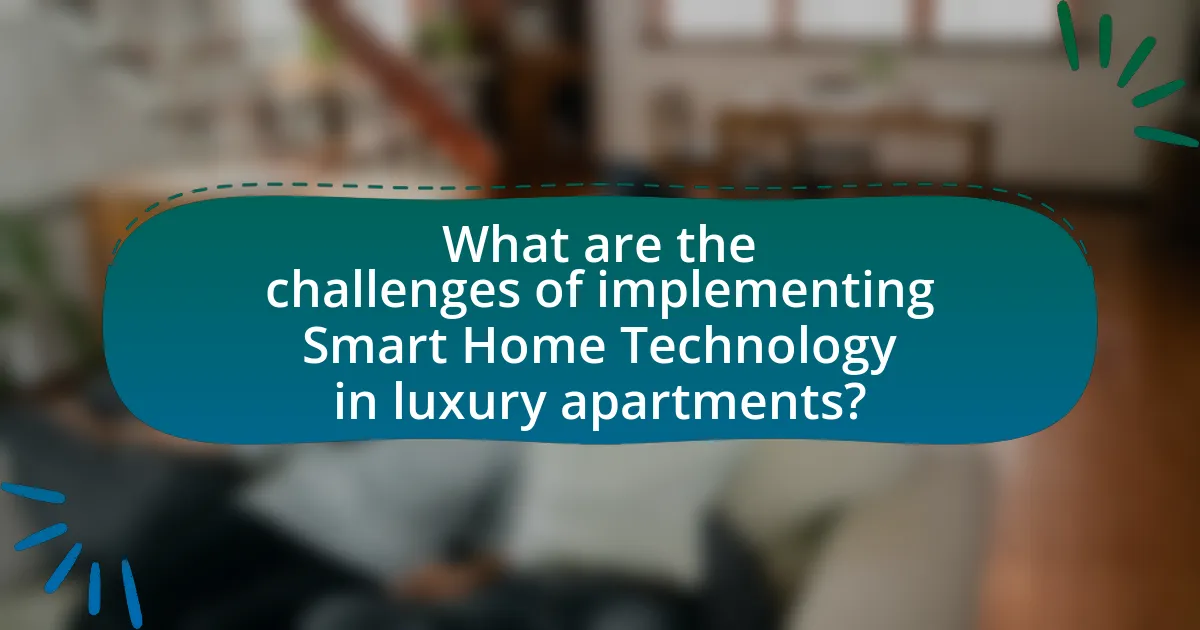
What are the challenges of implementing Smart Home Technology in luxury apartments?
The challenges of implementing Smart Home Technology in luxury apartments include high costs, compatibility issues, and privacy concerns. High costs arise from the need for advanced systems and installation, which can exceed budget expectations for both developers and residents. Compatibility issues occur when integrating various devices from different manufacturers, leading to potential functionality problems. Privacy concerns stem from the increased data collection and surveillance capabilities of smart devices, raising fears about unauthorized access and data breaches. These factors collectively hinder the seamless adoption of smart technologies in luxury living environments.
What are the common technical issues faced by residents?
Residents commonly face technical issues such as connectivity problems, device compatibility, and software malfunctions in smart home technology. Connectivity issues often arise due to weak Wi-Fi signals or network congestion, which can disrupt the functionality of smart devices. Device compatibility problems occur when different smart home products from various manufacturers do not integrate seamlessly, leading to operational challenges. Additionally, software malfunctions can result from outdated firmware or bugs in the applications controlling these devices, causing them to behave unpredictably. These issues highlight the complexities of managing interconnected smart home systems in luxury apartments.
How can residents troubleshoot these technical issues?
Residents can troubleshoot technical issues by first identifying the specific problem, such as connectivity issues, device malfunctions, or software errors. They should then consult the user manual or online resources provided by the smart home technology manufacturer for guidance on common troubleshooting steps. For example, resetting the device, checking Wi-Fi connections, or updating software can often resolve many issues. Additionally, residents can contact customer support for assistance, as many smart home systems offer dedicated help lines or chat support. This approach is effective because it leverages manufacturer expertise and documented solutions to common problems, ensuring residents can efficiently address technical issues.
What support options are available for residents experiencing problems?
Residents experiencing problems with smart home technology in luxury apartments can access several support options. These options typically include dedicated customer service hotlines, on-site technical support from property management, and online troubleshooting resources provided by technology vendors. For instance, many luxury apartments offer 24/7 customer service to address immediate concerns, while property management teams may have trained staff available for in-person assistance. Additionally, manufacturers of smart home devices often provide comprehensive online guides and FAQs to help residents resolve common issues independently.
How do privacy concerns affect the adoption of Smart Home Technology?
Privacy concerns significantly hinder the adoption of Smart Home Technology. Many potential users fear that smart devices may compromise their personal data, leading to unauthorized access or surveillance. A survey conducted by the Pew Research Center in 2021 revealed that 81% of Americans feel they have little to no control over the data collected by companies, which directly impacts their willingness to integrate smart technology into their homes. This apprehension is further exacerbated by high-profile data breaches and incidents of hacking, which reinforce the perception that smart home devices may not be secure. Consequently, these privacy issues create a barrier to widespread acceptance and utilization of smart home technologies in luxury apartments.
What measures can be taken to ensure data security?
To ensure data security in smart home technology within luxury apartments, implementing strong encryption protocols is essential. Encryption protects data transmitted between devices and the cloud, making it unreadable to unauthorized users. For instance, using AES (Advanced Encryption Standard) with a key size of at least 256 bits is a widely accepted practice that secures sensitive information. Additionally, regular software updates are crucial, as they patch vulnerabilities that could be exploited by cybercriminals. According to a report by the Cybersecurity & Infrastructure Security Agency, 85% of breaches involve unpatched vulnerabilities, highlighting the importance of maintaining up-to-date systems. Furthermore, employing multi-factor authentication (MFA) adds an extra layer of security by requiring users to provide two or more verification factors to gain access. This significantly reduces the risk of unauthorized access, as evidenced by a study from Microsoft, which found that MFA can block 99.9% of automated attacks. Lastly, educating residents about security best practices, such as recognizing phishing attempts and using strong, unique passwords, is vital for enhancing overall data security in smart home environments.
How do luxury apartment developers address these concerns?
Luxury apartment developers address concerns related to smart home technology by integrating advanced security systems, energy-efficient appliances, and user-friendly interfaces into their designs. These developers prioritize the installation of smart locks, surveillance cameras, and alarm systems to enhance security, which is a primary concern for residents. Additionally, they incorporate energy management systems that allow residents to monitor and control energy usage, addressing environmental sustainability and cost efficiency. For instance, a study by the National Multifamily Housing Council found that 70% of renters are willing to pay more for energy-efficient features, demonstrating the demand for such technologies. By focusing on these aspects, luxury apartment developers effectively meet the expectations of modern residents while ensuring a high standard of living.
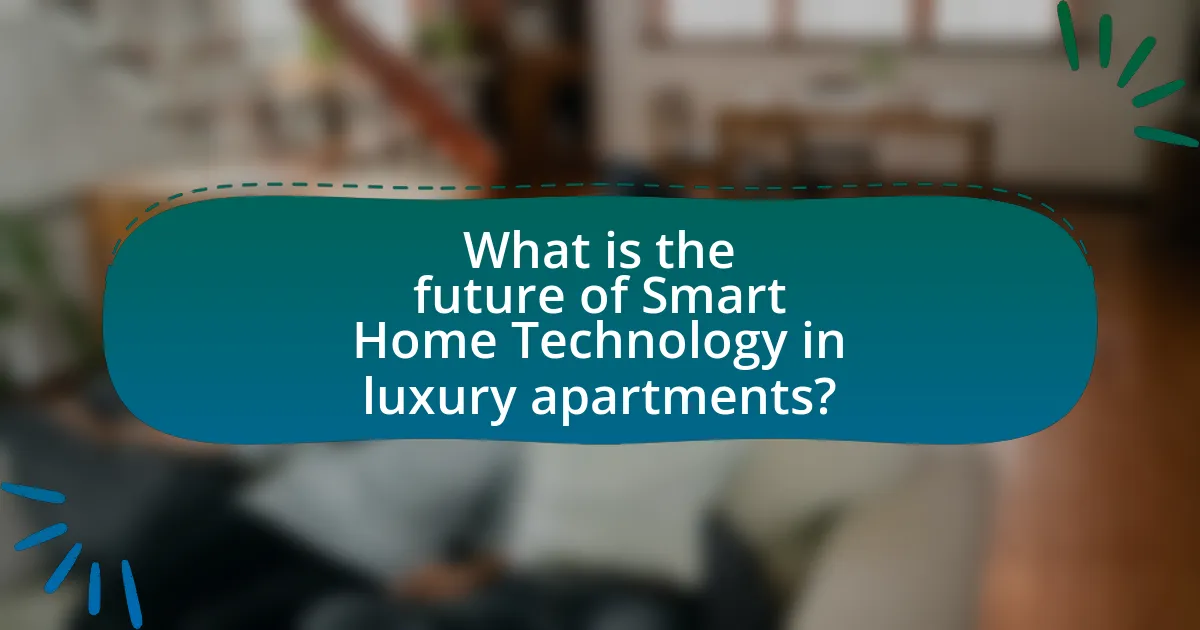
What is the future of Smart Home Technology in luxury apartments?
The future of Smart Home Technology in luxury apartments is characterized by increased integration of advanced automation, enhanced security features, and energy efficiency. As consumer demand for convenience and personalization rises, luxury apartments are expected to incorporate more sophisticated systems that allow residents to control lighting, climate, and security through mobile devices or voice commands. According to a report by Statista, the global smart home market is projected to reach $174 billion by 2025, indicating a significant growth trajectory that luxury apartments will likely capitalize on. This trend is further supported by the increasing adoption of Internet of Things (IoT) devices, which enable seamless connectivity and interoperability among various smart home systems, enhancing the overall living experience in luxury settings.
How will emerging technologies shape smart living in luxury apartments?
Emerging technologies will significantly shape smart living in luxury apartments by integrating advanced automation, enhanced security, and energy efficiency. Smart home systems, powered by the Internet of Things (IoT), allow residents to control lighting, climate, and appliances remotely, creating a seamless living experience. For instance, a study by Statista indicates that the global smart home market is projected to reach $174 billion by 2025, highlighting the growing demand for such technologies. Additionally, features like smart locks and surveillance cameras enhance security, providing peace of mind for residents. Energy management systems, which optimize energy consumption, contribute to sustainability and cost savings, aligning with the luxury market’s focus on eco-friendly living.
What innovations are on the horizon for smart home devices?
Innovations on the horizon for smart home devices include advanced AI integration, enhanced interoperability, and improved energy efficiency. Advanced AI will enable devices to learn user preferences and automate tasks more intuitively, while enhanced interoperability will allow different devices from various manufacturers to communicate seamlessly, creating a more cohesive smart home ecosystem. Improved energy efficiency technologies, such as smart thermostats and energy monitoring systems, will help homeowners reduce energy consumption and lower utility bills. According to a report by MarketsandMarkets, the smart home market is projected to grow from $80.21 billion in 2022 to $135.3 billion by 2025, indicating a strong trend towards these innovations.
How might consumer preferences influence future developments?
Consumer preferences will significantly influence future developments in smart home technology for luxury apartments by driving demand for personalized and integrated solutions. As consumers increasingly prioritize convenience, energy efficiency, and enhanced security, developers will focus on creating smart systems that cater to these specific needs. For instance, a survey by the National Association of Home Builders found that 70% of homebuyers are interested in smart home technology, indicating a strong market trend. This consumer interest will likely lead to innovations such as advanced home automation systems, energy management tools, and seamless integration with personal devices, shaping the future landscape of luxury living.
What best practices should residents follow to maximize their smart home experience?
To maximize their smart home experience, residents should prioritize seamless integration of devices, ensuring compatibility and centralized control through a single app or platform. This approach enhances user convenience and efficiency, as studies indicate that integrated systems can reduce energy consumption by up to 30%. Additionally, residents should regularly update their devices and software to protect against security vulnerabilities, as outdated systems are often targeted by cyber threats. Implementing automation routines, such as scheduling lights and thermostats, can further optimize energy use and enhance comfort. Lastly, residents should familiarize themselves with the features of their smart devices to fully leverage their capabilities, as proper usage can lead to improved functionality and satisfaction.
